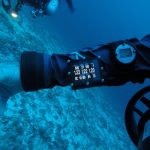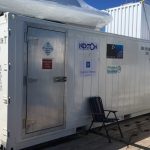Mission Day: Ten, Eleven and Twelve
 |
| Our Submersibles Nomad and Nemo with diver Graham Blackmore defending his underwater space! |
I am going to spend the majority of this blog on our dive from 28 July. That would be Mission Day 11 Why? Because it is now the epic dive (so far) of the project when you consider our overall goal: obtaining science, specimens and intel from this underwater world known as the Sargasso Sea, the only sea on the planet with no shore! And supporting the scientists aboard NektonMission.org.
 |
| The “Fountain”: Dive Boat |
27 July, we supported the Blue team from the Fountain at Spittal (the dive site on the northeast corner of the island). There dive was to collect SVS video from 300 feet / 90 meters, move up to 100 feet / 30 meters do the same and collect water samples, red algae samples (a new request from the science team) and coral (another new request!) which you have to carry clippers, large scissors if you will, and cut about a ¾” sample from the top of a colony. So now, we have even more to do…it is not boring…that is for sure. I do have to say that it does make the dives go faster and with less tedium.
They dropped at 10:05am and we picked-them up at a bit after 3p. A 5-hour dive and they accomplished all the underwater goals magnificently. It was a fairly calm day so the surface support operations that we conducted at the surface were fairly benign; I piloted the Fountain and was supported in the boat by me, myself and I. Yes, I was solo for that time but I passed the time with some great conversations with fish and turtles. Sometimes on expeditions of this magnitude, you have to do things that might not be easy but necessity demands adaptation and flexibility. I was happy to comply and had a great time.
 |
| The Water Monitoring Science Station |
28 July, we were up as the dive team at the North by North East site. Our plan?.. tri-fold; 1) conduct our usual SVS work at 300 feet / 90 meters, 100 feet / 30 meters, 50 feet / 15 meters along with collecting all the science, 2) find 50 feet / 15 meters of depth from underwater and 3) locate and mark that 50 feet / 15 meter site so that during our decompression we could help three scientist/divers from Stanford and the University of Oxford set up a water monitoring station. Sounds fairly straight forward. Lets fast forward to 300 feet
 |
| Sue Bird taking a minute to get “squared” away for an awesome shot by Graham at 60-65 feet setting up the “Science Station” |
Modifying our plan, we filmed a transect with a regular video camera that I manage during the dive for about 500-750 feet along the contour while Todd collected water samples and Sue supervised us both keeping the team intact. After 35 minutes, we began our ascent toward 100 feet. Nothing exiting along the way. We collected some water samples at 200 feet and about 25 minutes later we were at 100 feet. As I was managing the tow-fish line, I noticed it being slightly difficult to reel in and so I looked up…YEAH!!!! There was the SVS camera, coming down my line ready and working. We got our SVS transects, water samples and photos at 100 feet and were back on track.
Now it was time to find the 50-foot station, send up the marker buoy, greet the diving scientists and set up the science station. We hit the trigger on our scooters at high speed and headed in a 240 degree direction for what we thought would be about 1 – 1.5 miles landing us in 50 feet; not! After 94 minutes of scootering hard at full speed, about 2.5 miles, my scooter just quit! Battery dead! We only got as shallow as 65 feet and with one scooter dead, we sent up a note to the surface letting them know that this was it so if the scientist divers wanted to deploy, we would be there at the ready.
 |
| 32 GoPro’s mounted hemispherical! Awesome! |
After that 1.5 hours of additional decompression, we surfaced with a total run time of 380 minutes. Yes…that is 6 hours and 20 minutes underwater on about 50 cubic feet of breathing gas. I did not even wait go get out of my gear once on the boat before powering down a sandwich, chips, Gatorade, power bar and a liter of water. I was simply exhausted but am elated at what I can get my body to do at 55.
 |
| The Simrad GPS screen aboard the Fountain. |

 Previous Post
Previous Post Next Post
Next Post